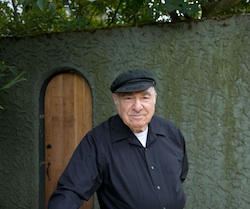Hazzan Isaac Azose’s CD, Ladino Reflections, took just six months to produce, but it took 20 years to dream. His double-disc collection of Ladino folksongs is the cherry atop a lifetime of Sephardic liturgical and cantorial achievements.
The CD follows Azose’s far-reaching contributions to the preservation of Turkish and Rhodesli Jewish customs and the Ladino language. Azose’s first CD, The Liturgy of Ezra Bessaroth, came out in 1999, and 2002 saw the release of his Seattle Sephardic Siddur, the only prayer book to follow the customs of Jews from Turkey and the Greek Isle of Rhodes.
The siddur became an overnight sensation and is used not only in Seattle but also in Sephardic congregations as far as Maryland and South Africa. In 2007, Azose published the Seattle Sephardic mahzor — festival prayer book — for Pesach, Shavuot and Sukkot.
Azose’s production of a Ladino album is a natural progression from his background as hazzan (cantor) of Ezra Bessaroth for nearly half a century. Born in 1930 to Turkish parents, Azose was intrigued with liturgy from a young age. He came to learn nearly all the synagogue liturgy by listening intently to the different Seattle hazzanim. Azose began working for Boeing in 1950, moonlighting as a hazzan in the early ‘60s at the site of the then-new Sephardic Bikur Holim, then called “The Branch.” In 1966 Azose became the hazzan of Ezra Bessaroth, where he remained until his retirement in 2000.
The preservation of Ladino language, in which he is fluent, is one of Azose’s passions. Also known as Judeo-Spanish, Judezmo, Spaniolit and a number of other names, Ladino is a Hebrew and old Spanish hybrid colored primarily by Turkish, Hebrew, Arabic and Greek and, to a lesser extent, Italian and French. Fewer than an estimated 200,000 people still speak this language, which became specific to the Jews after the Spanish expulsion in 1492. Efforts to preserve the language and culture are being made, particularly in Israel and in Internet forums like LadinoKomunita.
The origins of the 34 songs on Azose’s CD are virtually unknown. Riding the wave of migration, their roots can only be traced so far before they disappear into history. Whatever their beginnings, Sephardic life has preserved its Ladino romanzas, or romanceras, remarkably well. The folk songs appear to be part of some Sephardic collective unconscious.
“Some of these I’ve learned as part of the liturgy,” says Azose. “Some of them I’ve learned from Mom and Dad and their friends who used to get together on a Saturday night.”
He recalls listening to Ladino songs in his home as a child, when, before television, the adults gathered on Saturday nights to listen to records and dance.
The songs on Ladino Reflections capture those eternal themes of love: Love found, love lost, love forbidden. Cryptic and beautiful, “La Serena” (“The Siren”) begins: “If the sea were made of milk / And the boats of cinnamon / I would stain myself completely / To save your banner. / If the sea were made of milk / I would become a fisherman / I would fish for my sorrows / With little words of love.”
Each romanza should be a lesson for aspiring poets, many of them reminiscent of the biblical Song of Songs. The voice of “La Rosa Enflorese” (“The Rose Blooms”) sings, “The rose blooms in the month of May / My soul darkens suffering with love / Come quickly, dove, come quickly to me / (Come) quickly my soul, because I shall die.” The instrumental accompaniment of guitar, piano, mandolin and cittern — a three-string guitar popular during the Renaissance — appeals to the emotions of each song with a sound reminiscent of Spain and the Orient.
Although the folksongs largely speak of love, others, like “La Vida Do El Por Raki” (“I Would Give My Life for Arak”) attest to the fact that every culture has a drinking ballad. On the other side of the spectrum is “Kuando El Rey Nimrod.” In this uplifting folksong, Nimrod sees a holy light above the Jewish quarter predicting Abraham’s birth.
Several songs have experienced a rebirth, and tracing them back to their sources becomes a musicological excavation. For instance, “Miserlu” (Greek and Turkish: “Egyptian Girl”) is well known in Greek, Turkish and Arab cultures and likely filtered into Sephardic Jewry during its years in the Ottoman Empire. “Miserlu” was introduced to America in 1963 by Dick Dale (formerly Richard Mansour, a Lebanese American), and it spawned the genre of surfer rock, going on to be featured in the film Pulp Fiction. This catchy tune was most recently sampled in 2006 by hip hop group The Black Eyed Peas.
And no one can be sure whether “Adio Kerida” (“Farewell, My Love”) preceded or emerged from Verdi’s opera, La Traviata. Debate on this subject abounds. Rising star and Ladino Shakira Yasmin Levy, performs this haunting and mysterious song on her 2009 album, Mano Suave.
Hazzan Azose, who never received formal voice training, commands the album. He is accompanied on guitar by Asaf Erez and Julian Catford and on piano by Steve Rice. David Bartley accompanies on guitar, cittern and mandolin. The CD’s liner notes include the Ladino lyrics without English translations. The one exception is “Avrij Mi Galanika” (“Open Up, My Beauty”), about a young man begging his lover to let him inside. This song is depicted in the artwork throughout the CD booklet.
Ladino Reflections does not simply transmit music. It also transmits history and Ladino culture and language.
“I just wanted to have Ladino perpetuated, to leave a legacy for the Sephardic community of Seattle,” Azose says. “And my children.”
Hazzan Isaac Azose’s CD Ladino Reflections can be purchased online at www.isaacazose.com/LadinoReflections.html, on Ebay, and at performances around Seattle.
